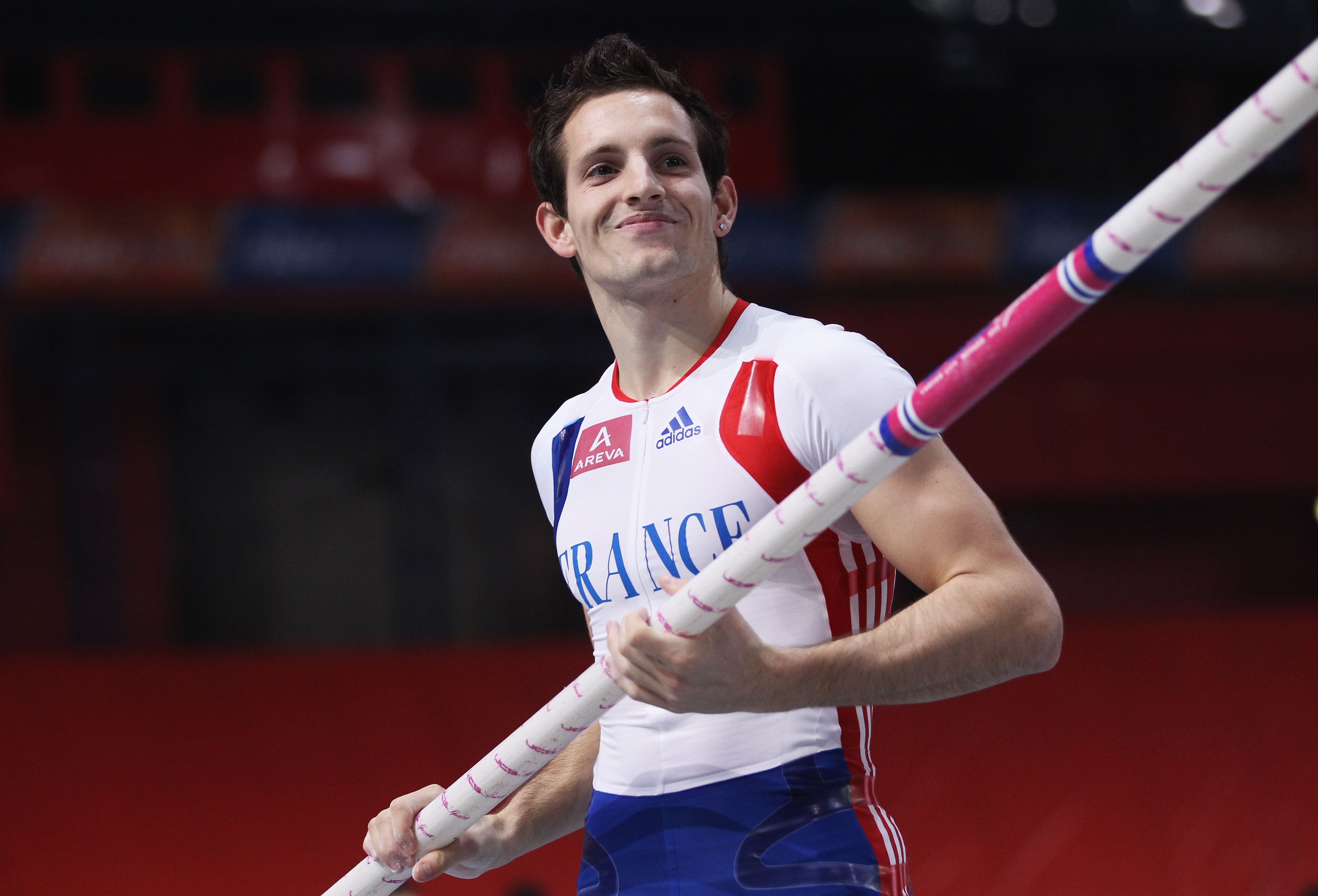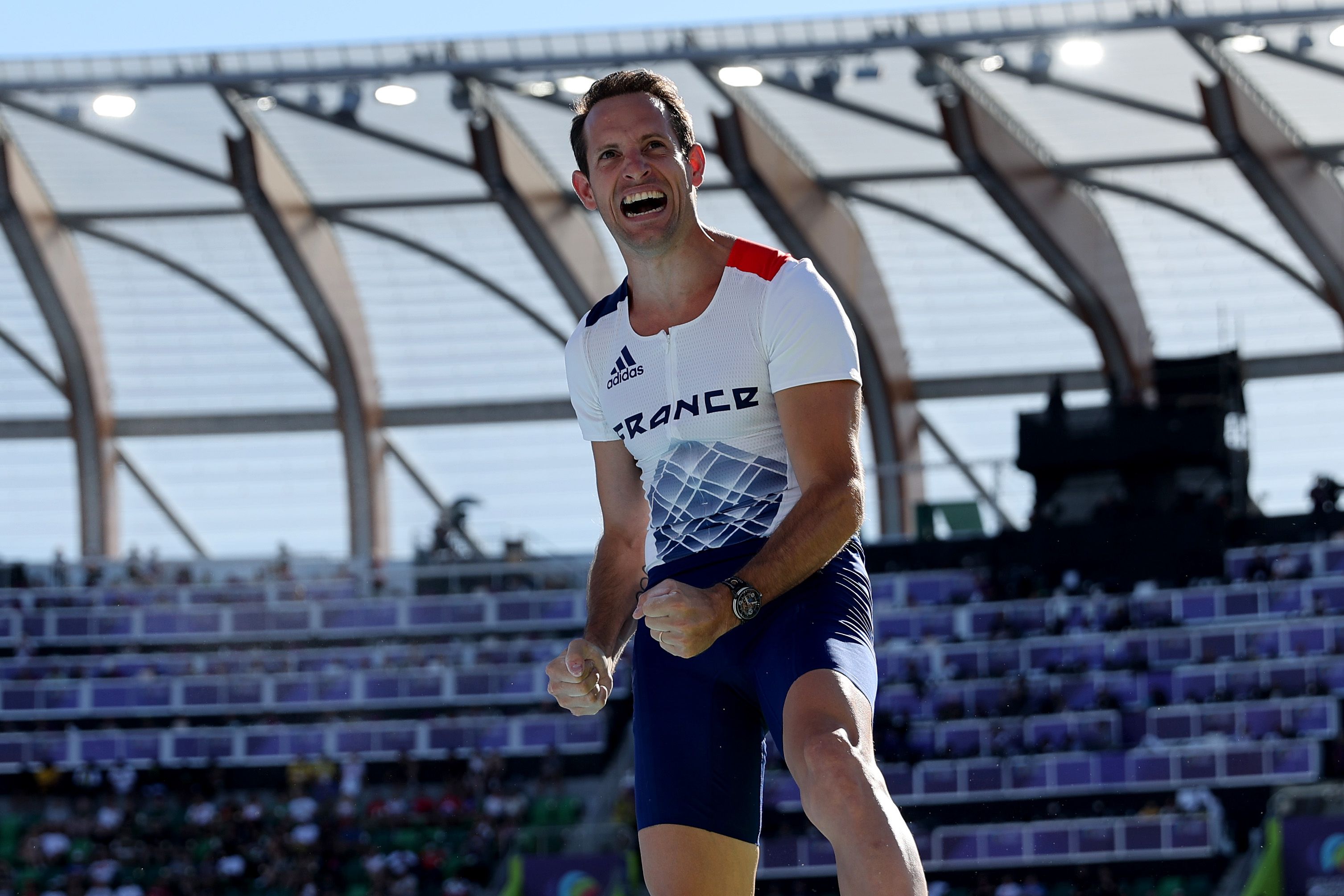Renaud Lavillenie clearing a world record of 6.16m at the 2014 Pole Vault Stars meeting in Donetsk (© Valeriy Bilokryl / Jean-Pierre Durand)
As Renaud Lavillenie stood at the head of the pole vault runway in the Druzhba Arena, steadying himself for his first shot at 6.16m in the Pole Vault Stars competition in Donetsk 10 years ago, he could not help glancing at the familiar face that flashed up on the giant screen.
There, laughing and joking, was Sergey Bubka, the man who had soared higher than any track and field athlete in history in the very same arena eight days short of 19 years previously.
Bubka’s indoor, and ultimately absolute, world record – 6.15m – had stood since 21 February 1993. No pole vaulter had come remotely close to threatening it.
Bubka's world record singlet is part of the World Athletics Heritage Collection which is displayed within the online 3D Museum of World Athletics and is currently on show in Glasgow at the MOWA Indoor Athletics Exhibition
The next best since then, Bubka apart, had been Lavillenie with a 6.08m clearance in Bydgoszcz on 31 January 2014 – a fortnight before he travelled to Ukraine.
At 27, the French athlete was clearly the rising force in the event. The Olympic champion in London in 2012 and silver medallist behind Germany’s Raphael Holzdeppe at the 2013 World Athletics Championships in Moscow, Lavillenie started the 2014 indoor season with a lifetime best of 6.03m but improved to 6.04m in Rouen on 25 January, then 6.08m in Poland six days later.
Not that his prospects of further progression towards 6.10m looked to be on the cards in Bubka’s backyard on the evening of 15 February 2014. It had taken Lavillenie three attempts to scrape over 6.01m before the bar was hoisted straight up to world record hight, 6.16m.
After glancing at the image of the watching Bubka, Lavillenie set his sights on the bar ahead, nodding to himself in assurance that the long-deemed impossible was indeed a realistic target. His plant was purposeful, his ascent arrow-straight and his clearance clean as a whistle.
As he hung momentarily in mid-air, Lavillenie flung his arms wide in triumph, his mouth agape in disbelief. The enormity of his achievement hitting home, he clasped his hands to his head as soon as he hit the landing bed.
He was still in a state of shock when Bubka rushed from the stands to congratulate him. “It’s completely unbelievable,” said Lavillenie. “I will need time to get back down to earth. It was a mythical record.
“I did not now what was happening to me out there. The sound was crazy. These are huge emotions. I am in a new dimension.”

Renaud Lavillenie after clearing a world record of 6.16m (© Valeriy Bilokryl / Jean-Pierre Durand)
Born to vault
Still, it is fair to say that Lavillenie was born to fly high.
The story went that his first experience of the pole vault had been on the beach with his father, Gilles, at the age of four. “Actually, the first connection I had with the pole vault was when I was one week old,” he corrected.
“When I got out of the maternity ward, my father had a competition at home. He put me on the mat. I was only 50cm tall. The mat was 5m by 5m, so it was quite big for a little baby.”
That was in September 1986 at the Lavillenie residence in Barbezieux-Saint-Hilaire, a sleepy town in the Petit Champagne area of south west France. Four years later, Lavillenie’s father, a budding vaulter, gave his son a small pole to use on the beach. Not until the grand age of seven did Renaud get the chance to attempt his first full-on vault.
As it happened, that was in the same year that Bubka achieved his 6.15m vault in his home city, one of the 35 world records the Ukrainian set indoors and out.
Lavillenie first joined the 6m club in 2011, vaulting 6.03m in Paris to claim the second of four European indoor titles. In March 2013 he cleared 6.07m at the third attempt at the European Indoor Championships in Gothenburg – only for his vault to be deemed invalid because the bar that he rattled bounced up on to the upright holders rather than remain resting on the pegs.

Renaud Lavillenie at the 2011 European Indoor Championships (© Getty Images)
It was obvious that day, as Lavillenie vented his frustration in the Scandinavium Arena – kicking out at the advertising hoardings, raging at the officials and collapsing in a heap of despair – that he was destined for bigger things.
After improving his outdoor personal best to 6.02m at the London Diamond League meeting in 2013, he had the bar raised to 6.16m in the arena where he had taken Olympic gold with a Games record 5.97m the previous year. He failed to clear it and then was beaten by Holzdeppe at the World Championships in Moscow.
New direction, higher grip
The setbacks were all part of the learning process. Lavillenie was adjusting to change under the direction of a new coach, Philippe D’Encausse, at his training base in the rugby union bastion of Clermont-Ferrand.
Lavillenie was rapid down the runway and lithe and dynamic at take-off. To better utilise those attributes, D’Encausse – a former international vaulter who finished eighth in the Olympic final in Seoul in 1988 and whose father, Herve, twice held the European record in the late 1960s – made adjustments to Lavillenie’s technique, switching him from a 5.10m pole to a 5.20m pole and getting him to grip the implement 7cm higher.
The idea was to increase the energy at the point of the plant and the results starred to show in those early 2014 indoor meets – before the quantum 6.16m leap in Donetsk.
“This is a new era for my old event,” Bubka proclaimed in the aftermath. “I am delighted for Renaud. I am sure he can go higher still.”
Lavillenie shared Bubka’s confidence. He had the bar raised by 5cm.
In attempting to soar, Icarus style, to 6.21m, however, the new world record-holder proceeded to crash on take off and lacerate his left ankle. He needed 15 stitches, missing the World Indoor Championships in Sopot.
“After jumping 6.16m, when I tried 6.21m it was not because I wanted to break the world record again,” Lavillenie insisted. “My goal was to try a jump that was 5cm higher and to see how my body was going to feel at that level.
“It was to prepare for the future - to see if I would be able to get this height in a future competition, to get the feeling for it.
“I tried the world record five times before I broke it, so it doesn’t happen every time. You can try the world record in training but you’re never in the same condition that you are in a competition.
“I always want more and 6.21 sounded good to me. It’s in my mind now. I had to know what it felt like to try it.
“I am still young. I’ve still got three very good years ahead of me, so we’ll see what will happen in the future.”
As it happened, the flying French athlete never made it over 6.10m again. His second best vault remained his 6.08m in Bydgoszcz from January 2014.
His third best, 6.06m, came indoors in Aubiere in February 2021, at the age of 34. That year Lavillenie reached his third Olympic final, finishing eighth, and in 2022 he placed fifth at the World Championships in Eugene.

Renaud Lavillenie in Oregon (© Getty Images)
Glittering career
At 36, he made a couple of Diamond League appearances last year – finishing eighth in Oslo and no-heighting in Stockholm – but managed a season’s best of only 5.61m.
It is four years now since Lavillenie lost his world record to Mondo Duplantis, the Swedish sensation who has raised global pole vault mark up to 6.23m, but as well as that 2012 Olympic gold and those four European indoor crowns the French athlete also boasts three world indoor and European outdoor titles and a silver and four bronze medals from the world outdoor championships.
Refreshingly, the free-spirited athlete also boasts more than one string to his sporting bow.
After the 2013 outdoor season, Lavillenie took part in the Le Mans 24 hour motorbike race, finishing 25th in the team race. He also pushed himself through the 10 events of the decathlon in the world class Decastar event in Talence, making a marked impression on Ashton Easton, the world record-holder and Olympic champion at the time, as he racked up 6670 points for 14th place.
“I already thought highly of Renaud, but after that I had huge respect for him,” Eaton said. “You can tell he’s a real sportsman. To me, that’s what it’s all about.”
Simon Turnbull for World Athletics Heritage





